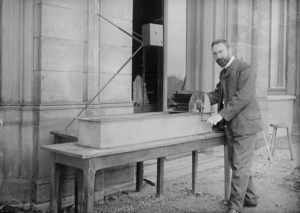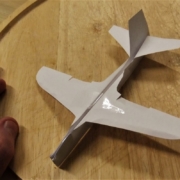Ludwig Prandtl 1875-1953 – The man behind the science of aerodynamics
Article by Dr Fred Starr PhD, FIMMM, FIE, MIMechE, CEng

Ludwig Prandtl is shown next to the water channel which he used in his early boundary layer investigations.
Ever wondered why you have to brush the dust off a piece of furniture? Not being able to blow it away? And were you puzzled that golf balls are knobbly rather than smooth? Surely a smoother ball should be more streamlined, and fly further? Or when boarding a jumbo jet, asked yourself why do the wings have to be so long, almost to the point of being floppy? Wouldn’t square shaped wings, attached along the length of the fuselage, be more sturdy?
The man who supplied us with the answer to these questions, the last one, being at one time a state secret, was Ludwig Prandtl, the greatest of all German Aeronautical Scientists. And a great bunch they were. Prandtl was there at the start of the business, when, although Lilienthal had died in his glider experiments, and the Wright Brothers had flown, there was no clear idea what kept an aircraft in the air. No one, in fact, had any idea, how best to design the most important attribute of an aircraft, the wings.

The unique form of paper glider evolved by Fred Starr between the ages of 10 and 16. The wings and tail have workable ailerons, flaps, elevators and a rudder.
Although an aircraft fanatic, I myself didn’t have any real appreciation of what makes an aircraft fly, until I was twenty, when I was in my first year at Battersea College in London. The understanding, came via Lynn Jones, someone who was to become a life long friend, who seeing me passing the time, launching my own unique paper gliders, gave me a battered paperback. It was the “Science of Flight” by OG. Sutton, and it was here I was introduced to Ludwig Prandtl and what he and his fellow countrymen had done for the science of aerodynamics.
In many respects this was the most important event of my academic career, despite it having nothing with the subject of my degree, Metallurgy. But what I read became the basis of a fair knowledge of how aircraft are designed, and in the last stages of my professional working life, kept me in a job.
Prandtl’s Grenzschicht
Probably not too many Germans will have heard of Grenzschicht, a word coined by the 29 year old Prandtl, to describe what we call the “Boundary Layer”. Was Prandtl looking far ahead to the outcome of the Brexit vote, when our new UK Government would be hoping, fairly desperately, for a very soft kind of Customs Barrier with the EU? Not a wall, simply an area of rough ground easily negotiated by a 40 tonne truck, so as to speak.
The boundary layer concept, in fact, not only clarified why one can’t blow away dust, it explained why, on a windy day, you must struggle against the oncoming gale. Up to that time, mathematicians had proved that not only would one be able walk freely even in the most violent hurricane, but hurricanes could not exist!
Prandtl’s idea was actually quite simple. He saw that the air molecules next to any surface, were, in effect, stuck on. Not moving at all. Even if the surface was the wing of a Jumbo Jet flying at 900 km/h. However, the layer of air molecules on top of these was moving just a bit, in the appropriate direction. In the boundary layer, each level was moving faster than the one below it, until at some point, the topmost layer was moving at the full aircraft speed.
Seems reasonable? That is why dust cannot be blown away. The particles are deep within the boundary layer. Prandtl’s genius was to use fairly simple maths to work out the thickness of the boundary layer. It varies with the speed. For a Jumbo Jet, it can be up to 15 mm deep.
The Lifting Line Theory
Prandtl’s boundary layer paper was presented at a conference in Heidelberg in 1904, and led to him being offered a professorship at Göttingen, where he set up an aerodynamics department. Come World War I with the vast expansion of aviation by all the participants, Göttingen prospered. Here, it is worth remarking, that because of the better understanding of how to design wing sections, German designs, particularly those coming from Göttingen, were streets ahead of those being used by the Allies. They were inherently stronger, and made take offs and landings safer.
We now come to the “Lifting Line Theory”. War winning Ideas and concepts need to be given verbal camouflage. What would an English spy, nosing around Göttingen, have made of the term “Lifting Line Theory” as he might have translated the word “Hebelinientheorie“? Another obscure piece of German philosophy……all about the climb to internal heavenly peace, maybe?
The concept, however, shows that if an aircraft wing is to be efficient, the span needs to be as wide as possible, keeping its width as narrow as possible, as we see on commercial jet aircraft. Structural considerations, of course, will determine what is feasible. Today we seem to have reached the limit. But not because of strength issues. For example, the wing span of the A380 Airbus, the world’s biggest aircraft, is less than ideal. The constraint being the size of aircraft hangers and parking areas.
Prandtl had to use some fairly involved maths in deriving the lifting line theory. But horror upon horror, in terms of secrecy, what came out of his efforts, is, perhaps, the simplest equation in all of aerodynamics. Hence the need for subterfuge.
Prandtl the Man
Even by the standards of German Academicians, Prandtl seems unusual. There is a story about him which is undoubtedly apocryphal, but may contain an element of truth. Thinking about marriage, the only girls Prandtl seems to have known really well were the three daughters of his former supervisor and collaborator, August Föppl. As the story goes, in 1909, when he was in his middle thirties, he wrote to Mrs Föppl asking her to select which one to become his future bride.
The biography by Prandtl’s son gives no hint of this, but we do know that the eldest daughter, Gertrude, broke off an engagement with another man. Quite soon afterwards, Prandtl wrote to Gertrude, asking for her hand, and all of her family were delighted when she accepted. Prandtl was a man who was known to be decent and he was going places.
This highlights another aspect of Prandtl’s character. It doesn’t always happen that the person who has come up with an outstanding scientific idea, gets to build up the R&D team and organisation. Then stay in charge, for over forty years. In academic scientific and engineering circles, it requires a combination of determination and diplomacy, with continuing ability to add to the knowledge and insights into an ever growing research team.
There is one final point. When Prandtl moved to Göttingen, although he had been recruited by the mathematician Felix Klein, it was agreed he was there to use maths to advance aircraft design. Not to turn aerodynamics into a minor subset of mathematical thought. Prandtl took this to heart. In coming up with new ideas he deliberately eschewed sophisticated maths. For me, having graduated in metallurgy, which I define as physics for the mathematically challenged, it means I stand a reasonable chance of understanding the basis Prandtl’s world shattering ideas.
Further writings and publications by Fred Starr are available online at FredStarr.com
Editor’s Note: While Prandtl’s technical studies translated into advances in fixed wing aircraft, in the early twentieth century German Vorsprung durch Technik also took the lead in creating and operating lighter-than-air craft lifted by hydrogen, the most famous being the Zeppelin.




